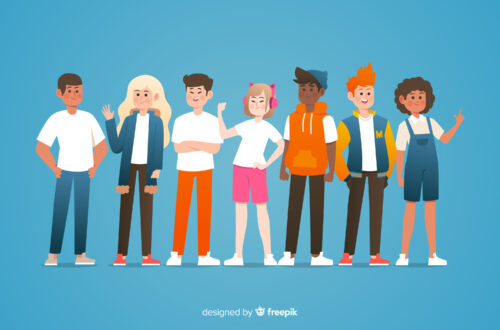Redesigning Math Courses for Distance Learning
Nearpod
Nearpod is an ingenious platform that allows teachers to create tech-infused lessons. I believe Nearpod can help teachers deliver quality instruction during distance learning that is also fun and engaging for students. You can find Nearpod online or by downloading the free app. There are synchronous and asynchronous options for teaching. On their website, Nearpod advertises: “Easily synchronize and control live lessons across all student devices. Seamlessly use your favorite web conferencing platform for distance learning settings.” However, there is also the option for asynchronous lessons that can be assigned to students so that they can access them anytime and anywhere. Perhaps you’ve also been trying to figure out how you can still differentiate to meet your diverse student needs? It would be easy to assign individual lessons to students after you have tailored the content to accommodate your student. Keep reading to learn more about this awesome tech tool.
What Makes Nearpod Stand Out in the Crowd
With Nearpod it is possible to find or create interactive lessons in minutes. In your lessons, you can embed videos, quizzes, polls, sways, Phet simulations, FlipGrid discussions, and mini slideshows (just to name a few!). There are various ways to keep students engaged during the lesson by allowing them to actively participate. For example, you can include interactive whiteboards for students to participate by drawing or showing their work. Or add virtual field trips to your lesson so that students can “experience” real-world examples and see places from around the world. You can also record your own voice over each slide or activity so that it feels like the presentation is happening right in your classroom. The audio recording tool is a great way to give students directions, encouragement, and support as they move through your asynchronous lesson. Another helpful feature is the ability to embed a website right onto a slide. That way students don’t have to go anywhere else to do their work. When you go to that slide in your lesson it will automatically load that webpage and students can interact with it just like they normally would online. Nearpod has great tools that you can use as formative assessments throughout your lesson, such as quizzes, polls, and the student draw tool. You can monitor student work on your teacher dashboard and give students timely feedback. If you choose to assess student’s learning by giving a quiz, they will be automatically graded for you and analytics provided.
Creating Lessons
“Upload and tech-enhance your existing materials or customize over 7,500 pre-made, standards-aligned lessons for all K-12 subjects.”
Nearpod.com
When creating Nearpod lessons you can use your own Powerpoint, Google slides, or PDFs as the basis for your instruction. After uploading your files, customize your lesson by inserting videos, interactive polls, or quick quizzes to keep students engaged and assess understanding.
Another really cool feature for Google users is to use their new Google slide add-on feature. After installing this add-on in Chrome, you can use the Nearpod tools while working in your Google slide presentation. All of the changes will sync automatically with your Nearpod lesson. If you don’t feel like designing your own lesson, feel free to scan the thousands of premade lessons and edit it to fit your needs. Another bonus for teachers is assignments can be integrated with your Learning Management System whether you use Google classroom, Microsoft Teams, Schoology, or other various platforms.
Nearpod Activities
“Classroom communities stay connected with collaborative activities and formative assessments like virtual reality, polls, collaborate boards, and game-based quizzes delivered through one seamless learning experience.”
Nearpod.com
Nearpod has a range of activities designed to increase student engagement.
- Collaborate: Students are prompted with a question and they can respond with text or pictures. It is a great way to conduct a live discussion or brainstorming session.
- Time to Climb: A gamified quiz. Start by adding your own question and a picture if you’d like. Next, fill in the multiple-choice answers or use images (great for pre-readers). One bonus is their additional options for older math students, such as the use of exponents or square roots. Teachers can set questions on a timer or easily edit their work by dragging questions or multiple choice answers around to rearrange. I found it very user friendly. However, the biggest drawback is that it is only multiple-choice questions, instead of having a range of choices like true/false or extended response.
- Bell Ringer Writing Prompts: Teachers can write a prompt and include an optional reference image or timer. You can allow students to submit text or audio recordings. I thought the audio recordings were really cool, especially for young students who have a hard time typing or for accessibility for other students who need additional support.
- Polls: Survey your students and receive feedback instantly. You can display the results for your class, choosing to either show or hide student names for privacy. This would be a great way for students to self-assess and provide teachers with quick feedback on who they need to pull and re-teach.
- More resources: There are other resources available for teachers include engaging Social-Emotional Learning (SEL) lessons or brain breaks.
If you want to try out Nearpod with your students check out their youtube channel, sign up for a webinar training, or access their collection of free pre-recorded webinars to watch on your own time.
Redesigning Your Math Course with Nearpod
We are all on a steep learning curve as we dive into distance learning. However, I think we’d all agree that traditional teaching methods are not as effective in a digital learning environment. Therefore, it is time to change it up! I watched this video from Edutopia on a highschool in Washington D.C. that had thrown out lecture-based teaching and replaced it with a self-paced, mastery-based approach to learning. I thought this flexibility would lend itself well to distance learning. Therefore, I started to brainstorm how Nearpod could be used to design an engaging, individualized digital learning environment for students that also allowed for student collaboration. Here’s my proposal:
Online Instruction
- Teachers design asynchronous Nearpod lessons they students can access and complete at their own pace. This seems like it would lend well to a distance learning environment since every family’s schedule is different.
- Students participate in answering questions throughout the lesson with the “Draw it” tool. This is a great way for teachers to check for understanding and catch misconceptions quickly.
- Since the lesson is not live, students can pause and rewatch parts as needed.
- When done, students will be required to complete a task to show mastery.
- Teachers can schedule “office hours” or collaboration time throughout the week for students to ask questions and work through questions together synchronously.
Mastery-Based Grading
- Students progress to the next lesson when they demonstrate mastery. This part must be done independently by the students.
- There are lots of fun tech tools that can be embedded in Nearpod lessons for students to show mastery. For example, teachers can use Nearpod’s own quiz feature or embed a Flip Grid discussion page for students to record videos explaining how they solved the problem. Or teachers can embed any website! For instance, check out Explain Everything. They have a digital whiteboard that allows students to demonstrate a problem and record audio. Or they could also complete a quick quiz on Quizlet or do an online Google form as an exit ticket.
- Teachers can schedule one-on-one reteach sessions with students if needed and then students can try to demonstrate mastery again. This is possible because there are no live lectures- the daily synchronous “classtime” becomes live sessions working with students.
Critical Questions:
Q: How do you effectively differentiate?
Perhaps teachers can create different Nearpod lessons for below, at level, and above grade level learners? However, this does seem like a large amount of work for teachers to create. Another option could be to let high students work through the “at level” lessons and then have an extension project for them to do.
Q: Is there a cut off at some point so that you can move on to the next math chapter?
I recognize teachers may run into a problem with this mode of learning if students don’t participate or struggle with managing their self-paced lessons. One idea I had was to create a student pacing guide that students can refer to in order to gauge if they are doing a good job staying on top of their lessons (i.e. by the end of week two complete 4 lessons). Just like in a Gen. Ed. classroom, we will always have students that struggle with different concepts. I would encourage teachers to reteach concepts to students and allow them to repeat lessons until the end of the chapter. If they only completed 3 out of the 6 lessons, they would receive a grade for the standards covered and they would receive a “no mark” for the content they did not cover.
Q: How can we involve more collaboration for students?
I think we need more contact and community activities besides live office hours where students can ask questions and work through problems together. I love the idea of having an end of the chapter collaborative performance task where students have to use all the skills they’ve learned from the chapter to solve a real-world problem or authentic task. But at this point, I’m not sure what that looks like with social-distancing. I’d love to hear any ideas you may have.
Helping Staff Implement Nearpod
I watched Nearpod’s webinar on “Implementing, Training and Supporting Teachers with NearPod”. They had some great suggestions for getting Nearpod off the ground at your school.
- Start by modeling Nearpod for your staff during your professional development session. Then they can see the product through the lens of a student. This directly ties in with ISTE Coaching standard 4d: Model the use of instructional design principles with educators to create effective digital learning environments.
- Try and engage teachers the same way you want to engage students. Let them experience how fun it is to go on a virtual field trip or see how engaged learners are when using the“Draw it” tool. This will help teachers buy-in.
- Try and hook their attention at the beginning of the Nearpod lesson.
- Show a video or a funny meme.
- Ask “How do you feel today about this training?” and let teachers respond with the Draw It tool,
- Take a virtual field trip to the beach and talk about what you’re going to do for your summer vacation.
- Use the Collaborate activity to pose an open-ended question or do a poll to ask staff if they are familiar with Nearpod.
- Gage the direction of your training by getting live feedback from interactive activities.
- Use a poll in the middle of the training on which Nearpod activities they want training on since you don’t have time to cover them all.
- Could use Collaborate at the end to brainstorm ways teachers can use Nearpod in their classroom.
- The objectives of your training should not just be to teach them about Nearpod, but also to motivate them to try using new technology. They are equally important!
- Give teachers time to use Nearpod and begin to develop a lesson for math or their specific content area. Be available to help when needed or give feedback.
- Create a Nearpod Planning Resource for teachers to use when creating a lesson.
Besides the webinar, Nearpod has other resources Digital Learning Coaches can use when introducing this tool to staff including a free Nearpod training lesson, facilitator guide, and audience checklist.
I’d love to hear about your experiences using Nearpod or your thoughts on individualized digital learning environments for students. Please comment below.
Resources
Basye, D. (2018, January 24). Personalized vs. Differentiated vs. Individualized Learning. Edutopia. Retrieved from: https://www.iste.org/explore/Education-leadership/Personalized-vs.-differentiated-vs.-individualized-learning
Edutopia. (2019, May 9). A Student-Centered Model of Blended Learning [Video]. YouTube. Retrieved from: https://www.youtube.com/watch?v=zrR-KIoggf4
Implementing, Training and Supporting Teachers with NearPod [Webinar]l Nearpod. Retrieved from: https://nearpod.com/blog/resources/#instructionalVideo
ISTE Standards for Coaches (n.d.). Retrieved from: https://www.iste.org/standards/for-coaches
Nearpod. (2020, August 6). What is Nearpod? [Video]. YouTube. Retrieved from: https://www.youtube.com/watch?v=cYVHSAqEeMM




4 Comments
Megan H
Thank you for sharing about Nearpod. We have several educators using it with students right now while it is free. The video you shared from the school in Washington DC was also very helpful and I am not thinking about how Nearpod or a platform like that can be used to replicate the model in the video during remote learning. I have been working with some math teachers in order to teach math using an exploratory method instead of direct instruction. This has been made harder during remote learning but I am wondering if something like Nearpod would help. Thanks again for sharing.
Jan White
Kaelyn, this is such a timely post as we are discussing how to do school next year knowing that many of our students will be synchronous, but we will also have a fair amount in each classroom who will be accessing their lesson asynchronously. Nearpod looks like an ideal solution. Thank you for the paragraph – what makes Nearpod Stand out from the Crowd; with so many options for remote learning tools popping into my mailbox right now, it’s overwhelming to hone in on one that might work. You helped clarify why Nearpod is worth investigating.
Rachel
Kaelynn,
I have been using Nearpod with my students for the last 2 years, and the information you shared was so helpful! I haven’t tried redesigning my math with Nearpod, and now I am really looking forward to trying it out! I have also found Nearpod to be really useful to leave when I’m out and have a substitute both as the plans and as activities my students work on. I also enjoyed the way you listed out how to help staff with Nearpod. That is something that has been a bit of a struggle as we have all adapted it. Thank you for sharing!
Doug Ferguson
Thanks, Kaelynn, for sharing! I definitely wanted to learn more about Nearpod and was looking forward to writing my own post until I got sidetracked with a different topic :). So, thank you for writing this post so that I can read and learn more about this like I had hoped :). I appreciate the tips, ideas, and overall recommendations around individualizing content. I’m also looking forward to hearing more about your experience with Nearpod as well as jumping in myself. Thanks again for sharing!